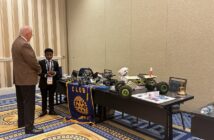JED: Elta has introduced the Scorpius family of EW systems over the past few years. What systems comprise the Scorpius family?
Licht: Scorpius is family of AESA EW products. It includes: airborne self-protection pod (Scorpius SPJ) ELL-8222SB; airborne support (EJ and SOJ) jammer (Scorpius SJ) ELL-8251SB; ground based jammer (Scorpius G) ELL-8256SB; naval EW system (Scorpius N) ELL-8256SB; and wideband threat emulator (Scorpius T) ELL-8257SB.
JED: The ELL-8222 self-protection pod has been a successful export item for ELTA. Can you tell us about its successor, the ELL-8222SB?
Licht: ELL-8222SB started production deliveries in 2023. It is aero-mechanically and physically very similar to 8222, but its performance is greatly improved relatively to ELL-8222 in three key performance areas: improved sensitivity, very high ERP and improved spatial selectivity. The performance improvement is achieved through the use of solid-state GaN amplifiers in AESA antenna arrays with staring multibeam in receive and focused beams in transmit.
JED: One of the customers of the ELL-8222 is the US Air Force. The 64th Aggressor Group at Nellis AFB uses the pod on its F-16s for “Red Air” training. Do you see a potential EW training role for the ELL-8222SB?
Licht: Indeed, ELTA has supplied numerous ELL-8222 pods to the US Air Force aggressor squadrons. As for ELL-8222SB, although its first application is to protect the Blue forces, the capabilities of the pod are equally relevant to emulate the capabilities of advanced Red force in training, and we expect to see air forces interest also in the role.
JED: The Scorpius T threat emulator is a relatively new offering from Elta. Can you tell us more about its basic capabilities and how it fits into modern EW training concepts?
Licht: The system’s wideband electronic steering antenna allows for simultaneous emulation of multiple emitters, effectively simulating different radar systems in different frequency bands and in different directions and accurately matching different radars characteristics. Scorpius T can simultaneously engage multiple aircraft in training – each one against different radar types. The ERP of Scorpius T is scalable and can match different requirements. The ground system is mobile so the training can be easily performed in different areas, as opposed to fixed, single-radar emulation of the legacy systems.
JED: What technologies upgrades do you expect to see in the future for the Scorpius family?
Licht: We definitely see continuous improvement effort on both front-end and back-end of the Scorpius family. On the front-end side, the development with continue to cover additional frequency bands and increased transmission power. In the back-end, AI will contribute to a better extraction of radar parameters and more effective selection of the optimal jamming technique.





